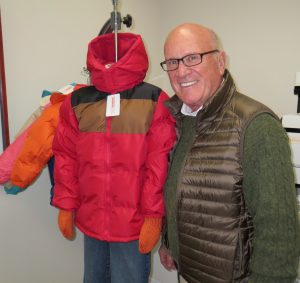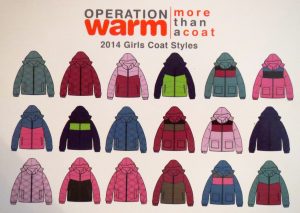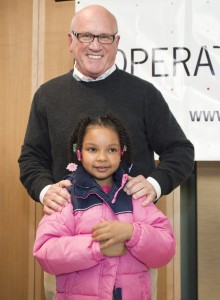In 1998 — after learning that some area schoolchildren were shivering at bus stops — a Pennsbury Township man bought up the entire stock of children’s coats at Sheldon’s, a now-defunct Kennett Square department store.
Not surprisingly, the request prompted inquiries from the store’s skeptical staff, but once Dick Sanford explained his intentions, he completed the transaction and walked out with 58 coats that were given to youngsters who needed protection from the cold.

By 2002, Sanford had founded Operation Warm, a Chadds Ford-based nonprofit that has distributed 1.7 million coats to needy children — a number that the retired, 71-year-old entrepreneur expects will top two million next year.
“The size of the problem is enormous,” Sanford said during a recent interview, pointing out that 31 million children qualified for the federal free lunch program last year. “Just imagine a child who never asked to be born … thrown into a situation of poverty. I believe it’s every human being’s responsibility to look around us and help others in need.”
Toward that end, Sanford has parlayed his business acumen into running an efficient nonprofit. A former executive vice president of Commodore International, Sanford created Intelligent Electronics in 1982, a booming micro-products wholesaler that was gobbled up by Xerox in 1998 for $415 million.
Sanford, a father of five and grandfather of two, said he was grateful that his business success gave him the credibility he needed to attract key staffers, a heavyweight board of trustees, and an ever-expanding roster of energetic partnerships. “You can’t do it alone,” he said. “You need a great team around you.”
It also helped that his wife of 30 years, Sheila, was amenable to his desire to build another empire.
Sanford said he has worked hard to remain lean and to grow aggressively but cautiously. “You have to keep the brakes on or you’ll roll over,” he said. Although the nonprofit has dramatically expanded its scope and reach — it now operates in 43 states — it utilizes a staff of only 17.
Sanford said keeping operating costs low leaves “more money for coats,” and volunteer partnerships help realize that goal. Some of the largest are Rotary, the Auto Dealers CARing for Kids Foundation, and the International Association of Fire Fighters (IAFF).
Typically, the partnerships have also burgeoned. For example, an early article about Operation Warm appeared on the Rotary International web site. Sanford had pitched the idea of distributing coats to the Longwood Rotary, where he was a member, and he received an enthusiastic response that has continued to resonate throughout the organization.

Sanford also found traction with the auto dealers’ foundation. In October, it distributed 37,606 new coats — another number that continues to increase — through a growing network of YMCAs, schools, churches, homeless shelters, and other social service agencies.
Sanford said the partnership with the firefighters has been particularly gratifying because it advanced his long-sought goal of manufacturing the coats in America. He explained that one way he kept costs down was to order directly from a manufacturer; however, the American production costs were far from competitive.
Rather than reduce the number of children receiving coats, Sanford said he opted to import them, but he never abandoned his quest to base the manufacturing in the U.S. He said the firefighters’ group, bound by a charter that prohibited non-U.S. donations, found a struggling clothing plant in Selma, Ala., which is now producing the coats that it distributes – and employing about 200 who had been facing layoffs.
Although the cost is still more than double the overseas price tag, Sanford said he is optimistic that eventually the bulk of the coats will come from the U.S. He is similarly hopeful that the cost of creating the coats from recycled materials will also come down. “Wouldn’t it be great to have a coat made from water bottles?” he said, citing the environmental benefits.
Sanford said students from Villanova University and the University of Pennsylvania have worked on projects to make the coats from recycled plastic bottles, a process that even spawned an environmental curriculum for Villanova's department of geography and the environment.
But even if the coats could be created from discards, they will never be identifiable as such, Sanford vowed, explaining that it’s important to avoid stigmatizing the children with an obvious handout. Each year, his team works to come up with the latest styles and colors and to ensure that any particular group receives a variety.
Sanford said he has witnessed the excitement the kids experience when they receive a fashionable new coat that’s different from everyone else’s. To further boost self-esteem, the coats have an inside label where the children can write their names. “It’s an amazing experience to see the look on their faces when they get a new coat,” Sanford said.

Such experiences energize him. Eager to share the positive impact of making a difference in a child’s life, Sanford said he is always looking for new partnerships and initiatives, but sometimes they find him first. A recent request from UNICEF resulted in providing coats for winter clothing kits being prepared for Syrian refugee children.
The nonprofit has also been enlisted to help respond to both natural and man-made disasters in the U.S., ranging from fires to hurricanes, floods, earthquakes, and tornadoes.
Sanford said he doesn’t see those services ending anytime soon. “I suspect there will always be a crisis occurring somewhere in the world,” he said.
Operation Warm offers many different ways to get involved. Students are encouraged to adopt the nonprofit as a service project. Individuals can work as volunteers or fund-raisers. Organizations such as schools, churches, or other service groups interested in providing coats to children can raise funds and place orders.
For those interested in making monetary contributions, many employers include Operation Warm in their ongoing employee giving campaigns, which sometimes include an employer match. The nonprofit also accepts corporate or individual donations, which can be designated in honor of someone. Each $20 provides another child with a new winter coat, Sanford said.
He said his perpetual search for new approaches led recently to Toms Shoes, and he is considering copying the “one for one” model the company has made famous. “If someone buys a coat, we’ll give another one to a child in need,” Sanford said.
Despite the obstacles of running a retail business, Sanford can’t rule out the possibility. “I can see that happening,” he said, pointing with pride to one of the coats destined for a child and deeming it retail-worthy.
For more information on Operation Warm, visit http://www.operationwarm.org. To make a donation online, go to https://donate.operationwarm.org/page/contribute.

Comments